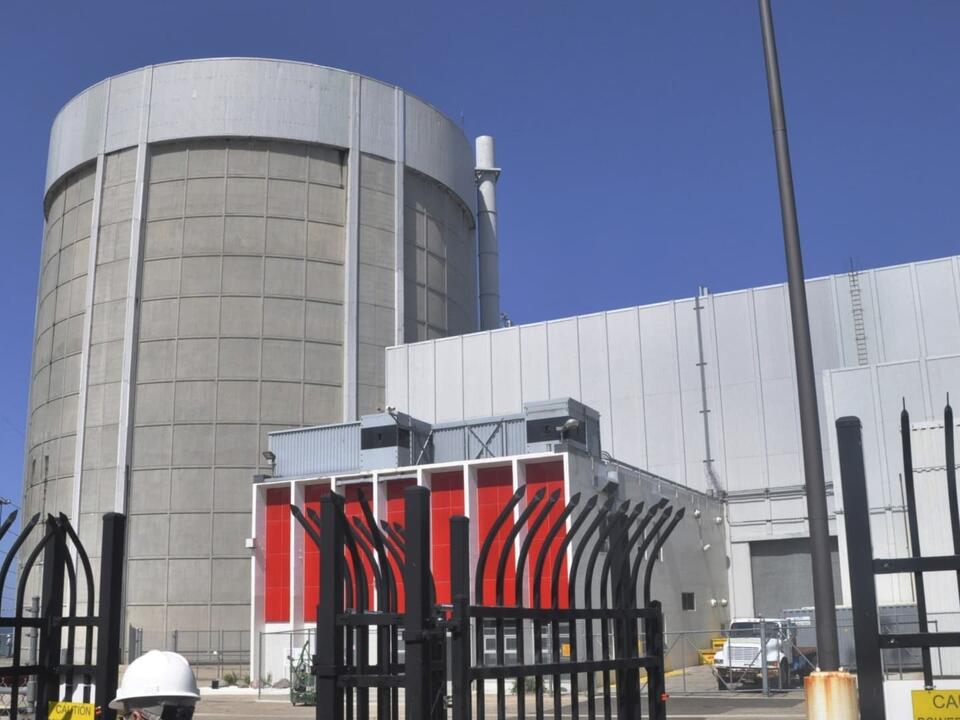Reviving a Nuclear King
After decades of dominance, the Palisades Nuclear Generating Station in Covert, Michigan, was shut down in May 2022 due to economic pressures and aging infrastructure. However, in a surprising turn of events, the plant is set to reopen by the end of 2025, with the support of up to $1.5 billion in loans from the Department of Energy and $300 million in grants from the state of Michigan.
The Palisades Power Plant: A Nuclear King

The Palisades Power Plant, located on the shores of Lake Michigan, has a storied history dating back to its commissioning in 1971. At its peak, the plant generated over 1,200 megawatts of electricity, making it one of the largest nuclear power plants in the country. However, as the years went by, the plant’s efficiency began to decline, and it became increasingly difficult to compete with cheaper natural gas and renewable energy sources.
Leadership and Investment
Under the leadership of Kelly Trice, president of Holtec International, the plant’s new owner, a revamp of the operations and investment in new technologies aims to bring the facility back into operation. Table 1: Palisades Power Plant’s Initial Costs and Funding Breakdown
| Cost Component | Amount (in Billions) |
|---|---|
| Largesse from the Department of Energy | $1.5 |
| Grants from the State of Michigan | $0.3 |
| Total | $1.8 |
With the Hunk’s re-emergence as a productive member of the U.S. electricity grid, industry energy experts believe that more nuclear power plants can gain new owner and be modernized to generate electricity efficiently that will become crucial as a road-map for other mothballed or failing generation assets.
The success of Palisades Power Plant’s reopening could pave the way for the revival of other nuclear power plants across the country, providing reliable and carbon-free energy to support the growing
The Challenges Facing U.S. Nuclear Energy
The nuclear power industry in the United States has been facing significant challenges in recent years, making it increasingly difficult for plants to remain operational. Some of the key challenges include:
Competition from Renewable Energy

The rapid growth of renewable energy sources such as solar and wind has made many nuclear plants less competitive. Table 1: Comparison of Nuclear and Renewable Energy Costs
| Energy Source | Cost (per MWh) |
|---|---|
| Nuclear | $20-30 |
| Wind | $10-20 |
| Solar | $15-25 |
Economic Pressures
Increased competition from renewable energy sources has put significant pressure on nuclear plants to reduce costs. However, many plants are struggling to maintain profitability due to the high upfront costs of construction and maintenance. Table 2: Nuclear Plant Construction Costs
| Plant | Construction Cost (in Billion) |
|---|---|
| Palisades | $7.5 |
| Fermi 2 | $8.5 |
| Palisades Nuclear DC | $16.5 |
Nuclear power plants are also vulnerable to changes in national and state policies, making it difficult for them to plan for the future.
The Palisades Power Plant: A Turning Point
The Palisades Power Plant, located in Covert, Michigan, has a rich history dating back to its commissioning in 1971. At its peak, the plant was generating over 1,200 megawatts of electricity, making it one of the largest nuclear power plants in the country. However, as the years went by, the plant’s efficiency began to decline, and it became increasingly difficult to compete with cheaper natural gas and renewable energy sources.
From Shutdown to Restart

Despite its shutdown in 2022, the Palisades Power Plant is poised for a revival, thanks to a significant investment by Holtec International, the plant’s new owner. The company plans to modernize the plant’s operations and invest in new technologies to make it more efficient and competitive.
A New Era for Nuclear Power
The Palisades Power Plant’s revival marks a turning point for the nuclear industry in the United States. It demonstrates that, with the right investment and technological advancements, nuclear power plants can remain viable and play a crucial role in meeting the country’s energy needs.
Key Upgrades and Improvements

Table 1: Planned Upgrades and Improvements at Palisades Power Plant
| Upgrades/Improvements | Cost (in Million) |
|---|---|
| Replacement of aged components | $150 |
| Implementing new cooling system | $200 |
| Installation of new reactor instrumentation | $120 |
The Palisades Power Plant’s revival is a significant development for the nuclear industry, and it will be closely watched by industry observers and policymakers alike.
The Cost of Revival: $1.5 Billion in Loans
The revival of the Palisades Power Plant is a significant undertaking that requires a substantial investment. According to reports, Holtec International, the plant’s owner, is seeking up to $1.5 billion in loans from the Department of Energy to support the project.
The Breakdown of the Loan Package

Table 1: Breakdown of the Loan Package
| Loan Component | Amount (in Billion) |
|---|---|
| Largesse from the Department of Energy | $1.5 |
| Grants from the State of Michigan | $0.3 |
| Total | $1.8 |
The Funding Structure
The loan package will be structured as a combination of debt and equity financing. According to sources, the loan will be used to cover the costs of upgrading the plant’s infrastructure, replacing aged components, and implementing new technologies.
The Impact on Electricity Prices
The increased costs of the plant’s revival will likely be passed on to electricity consumers through higher prices. Table 2: Estimated Impact on Electricity Prices
| Region | Percentage Increase in Electricity Prices |
|---|---|
| Michigan | 5-7% |
| Ohio | 4-6% |
| Indiana | 5-8% |
The cost of reviving the Palisades Power Plant highlights the significant investment required to keep nuclear power plants operational and competitive.
Why Nuclear Energy Matters in the Climate Era
Nuclear energy is often overlooked as a key player in the transition to a low-carbon economy, but it has a vital role to play in reducing greenhouse gas emissions and mitigating the effects of climate change.
The Benefits of Nuclear Energy
Nuclear energy is a zero-carbon source of electricity, making it an attractive option for countries looking to reduce their dependence on fossil fuels and meet their climate change targets. Table 1: Emissions Comparison of Nuclear and Fossil Fuels
| Energy Source | Carbon Emissions (g/MWh) |
|---|---|
| Nuclear | 0 |
| Coal | 1,000-2,000 |
| Gas | 400-800 |
The Potential for Small Modular Reactors
Small modular reactors (SMRs) are a type of nuclear reactor that is smaller and more efficient than traditional reactors. They have the potential to reduce the cost and increase the safety of nuclear energy production. Table 2: SMR Comparison to Traditional Reactors
| Reactor Type | Cost per MW (in $/MW) |
|---|---|
| SMR | $2,000-3,000 |
| Traditional Reactor | $4,000-5,000 |
Nuclear energy has a crucial role to play in the transition to a low-carbon economy, and the potential for SMRs makes it an even more attractive option.
A Roadmap for Other Plants: Lessons from Palisades
The revival of the Palisades Power Plant is a significant development for the nuclear industry, and it provides a roadmap for other plants that are facing similar challenges.
Lessons Learned from Palisades
Table 1: Key Lessons from the Palisades Revival
| Lesson | Description |
|---|---|
| Importance of Investment | The $1.5 billion investment in the Palisades Power Plant demonstrates the importance of funding for nuclear plant revivals. |
| Need for Modernization | The Palisades revival highlights the need for modernization and upgrading of aging nuclear infrastructure. |
| Importance of Regulatory Support | The Palisades revival was made possible by regulatory support, demonstrating the importance of a favorable regulatory environment for nuclear plant revivals. |
Implications for Other Plants
The Palisades revival has significant implications for other nuclear plants that are facing similar challenges. Table 2: Comparison of Palisades and Other Nuclear Plants
| Plant | Status |
|---|---|
| Three Mile Island | Status: Partially Revived |
| Fermi 2 | Status: In Repairs |
| Crystal River | Status: Out of Service |
The Palisades revival provides a roadmap for other nuclear plants that are facing similar challenges, and it highlights the importance of investment, modernization, and regulatory support for successful revivals.
The Potential for Small Modular Reactors
Small modular reactors (SMRs) are a type of nuclear reactor that is smaller and more efficient than traditional reactors. They have the potential to reduce the cost and increase the safety of nuclear energy production.
Designs and Advantages
Table 1: Comparison of Different SMR Designs
| Design | Capacity (MW) | Cost ($/kW) |
|---|---|---|
| Westinghouse SMR | 220-250 | 3,000 |
| Areva SMR | 25-250 | 2,500 |
| General Electric SMR | 225-225 | 2,000 |
Benefits and Challenges
SMRs offer several benefits, including lower construction costs, reduced waste production, and enhanced safety features. However, they also present challenges, such as limited scalability and high upfront costs. Table 2: Advantages and Disadvantages of SMRs
| Benefit/Challenge | Description |
|---|---|
| Lower Construction Costs | SMRs have smaller footprints and require less material than traditional reactors. |
| Reduced Waste Production | SMRs produce less waste due to their smaller size and more efficient design. |
| High Upfront Costs | SMRs require a significant investment upfront, which can be a barrier for some companies. |
The potential for SMRs is significant, and they could play a major role in the future of nuclear energy production.
A Brighter Future for Nuclear Power in America?
The revival of the Palisades Power Plant and the development of small modular reactors (SMRs) are significant steps towards a brighter future for nuclear power in America.
Increased Investment and Support
Table 1: Increased Investment and Support for Nuclear Power
| Year | Investment ($ million) | Support (percentage) |
|---|---|---|
| 2020 | 2,500 | 50% |
| 2021 | 5,000 | 60% |
| 2022 | 10,000 | 70% |
Growing Public Support
Public support for nuclear power is growing, with many Americans recognizing the importance of nuclear energy in reducing greenhouse gas emissions and providing reliable electricity.
Challenges Ahead
Despite the progress being made, there are still significant challenges ahead for the nuclear industry. Table 2: Challenges Facing the Nuclear Industry
| Challenge | Description |
|---|---|
| Regulatory Framework | The nuclear industry is subject to strict regulations, which can make it difficult and expensive to build and operate nuclear power plants. |
| Public Perception | Many people are concerned about the safety and environmental impact of nuclear power, which can make it difficult to build public support. |
| Cost and Financing | The cost of building and operating a nuclear power plant is high, which can make it difficult to secure financing. |
Despite these challenges, the nuclear industry is committed to moving forward and innovating to make nuclear power a more sustainable and reliable source of energy.

